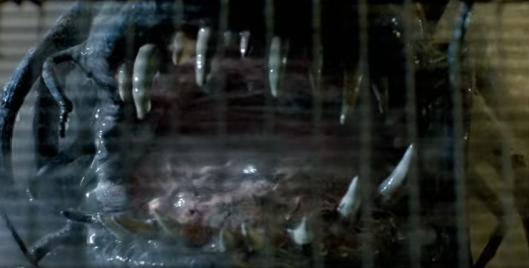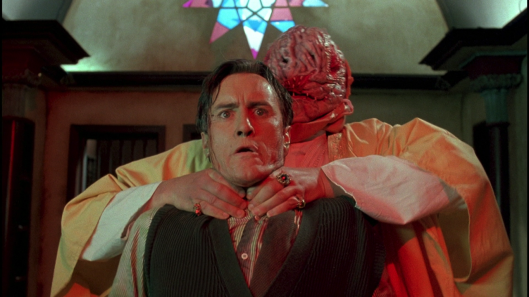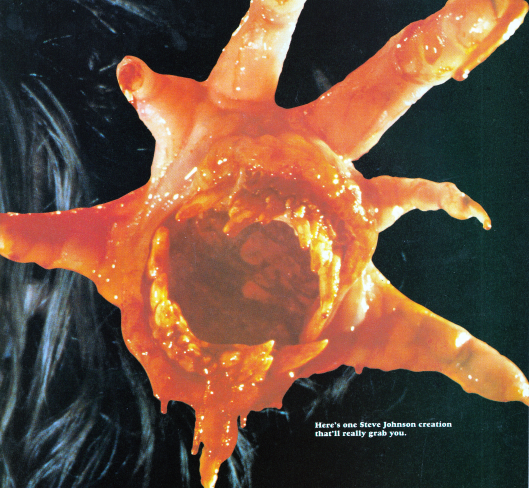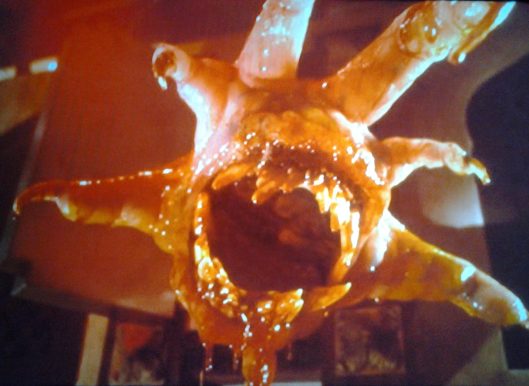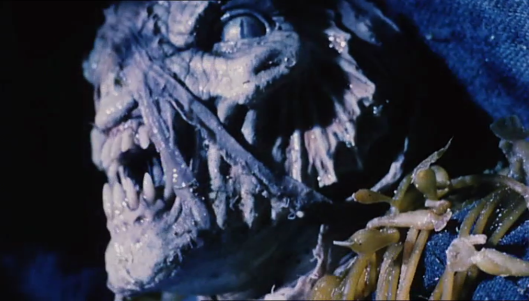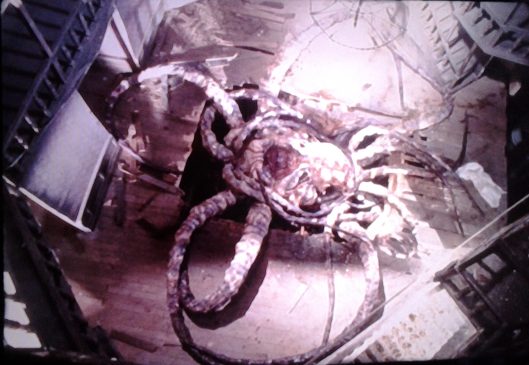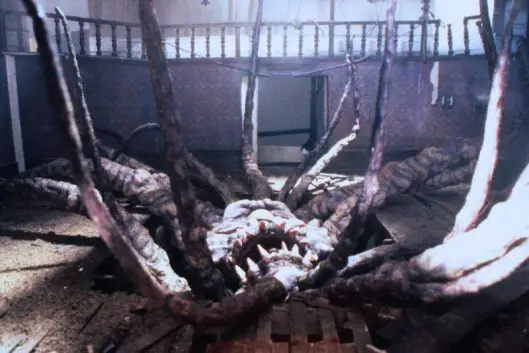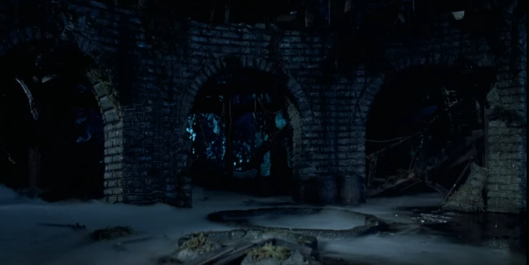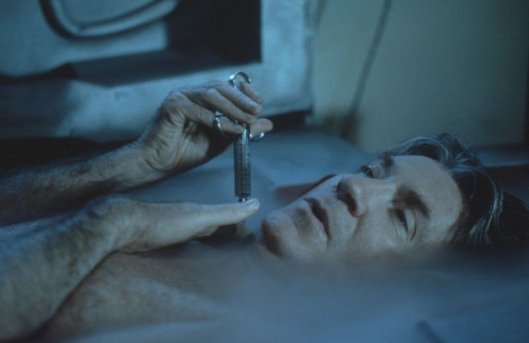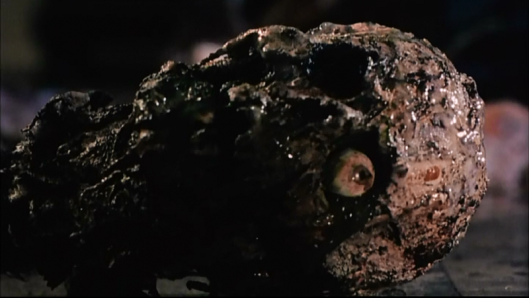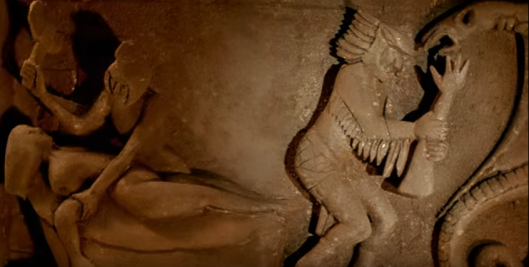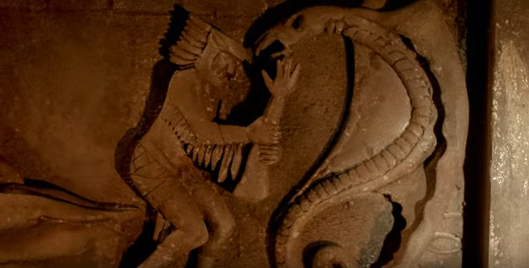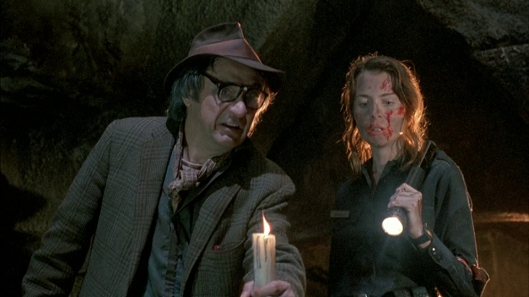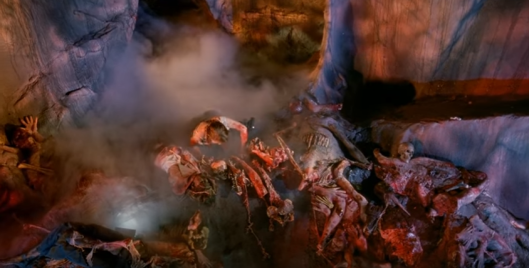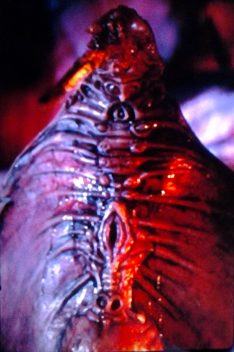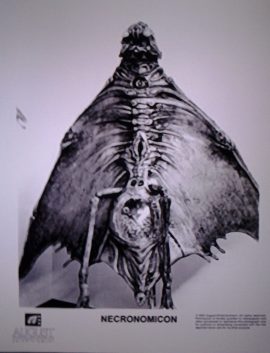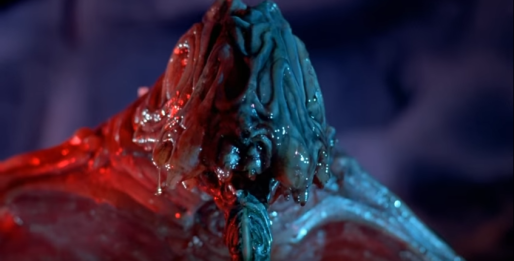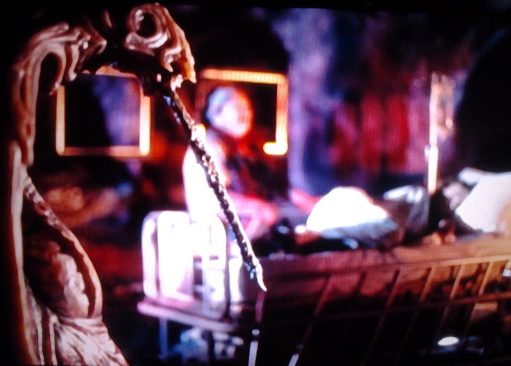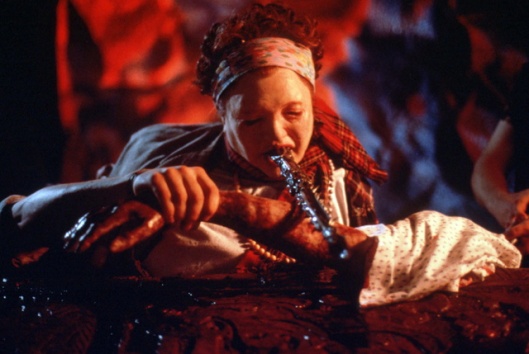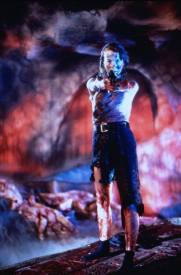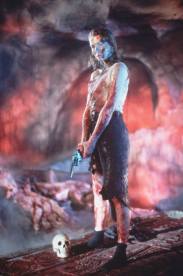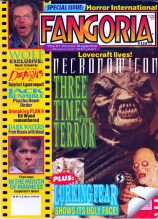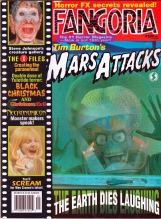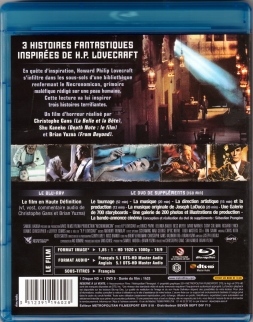When I first heard about Necronomicon it was initially touted as an anthology of three Lovecraft stories: The Rats In The Walls, Cool Air, and The Whisperer In Darkness. The final stories, “The Drowned”, “The Cold.” and “Whispers” each helmed by a different director ended up being more in the way of “loose inspirations,” but they were imbued with enough “Lovecraftian” overtones that still managed to please this reviewer.
I contacted Brian Yuzna on Facebook and asked him why he went with a “loose adaptations” and he told me . . .
Except for Cool Air the stories underwent a lot of changes. Each director was free to do the adaptation he wished. My original story was Whisperer in the Darkness- but when I saw the scripts for the other two films, I felt like mine would probably be last and should probably be more urban and dirty to balance the others. Brent Friedman wrote the final versions of each of the scripts.
The movie starts off with a wraparound story, “The Library,” (directed by Brian Yuzna), this link to all three segments focuses on Howard Phillip Lovecraft himself. Since this was Yuzna’s brainchild it’s no surprise Jeffery Combs plays the author complete with make-up that changes his look, giving him a different nose and chin to try and make him look more like the author. This segment puts forth the idea that, perhaps, not all his tales were a product of his imagination. Then where did they come from? Straight from the pages of the Necronomicon itself! The supposedly fictional tome is real, and he heads to the one library where he’s learned it’s being stored and guarded by a clandestine order of Ommiad monks who appear human, but are anything but. ![]()
They keep the book in a strange “puzzle box-like” vault on the bottom floor protected by a jailhouse door. Lovecraft pickpockets the crucial key needed to get into this room and skulks downstairs seemingly unaware. The grating on the floor appears to imply the room may be constructed on top of a huge SeaWorld-like container in which dwells a tentacled monstrosity. This could be another piece of “security” by the monks. The vault itself seems to have some hidden “security measures” as well, and they’re tripped just as Lovercraft slips the magnificent looking tome out. He plops it down on the table, takes out a pen and notebook and begins jotting down notes. This is how the movie segues into the other segments. Lovecraft is reading terrifying accounts of nightmarish excursions humans have made into this hidden world of Cthulhu and his spawns throughout history, and this includes the future.
After each segment the movie cuts back to Lovecraft looking sweaty, exhausted and terrified by what he’s just read. After the final segment concludes one of the monks discovers him and tells him to put the book back. It’s revealed he has indeed tripped something into happening inside the vault that involves the appearance of a dimensional gateway out which will come a monstrous, fleshy nightmare! We also see how not human the monk is. After Lovecraft has dropped the key accidentally into the grating in the floor, and while doing brief battle with a Cthulhu-ish creature through the grating, the monk squeezes impossibly past the bars and tries to put Lovecraft into position to be gobbled up by this coming nightmare. Struggling with the monk, Lovecraft tears the man’s human guise away (see photo below) and it is he who gets gobbled up instead by a a creature that looks like a giant, deformed hand with a maw for a palm! Lovecraft steals the Necronomicon and flees the library.
BEHIND THE SCENES
The movie’s first tale is called, “The Drowned,” and its final form really has no visible semblance to “The Rats In The Walls.” That tale is about a man who moves back to his ancestral home and restores it, then comes to learn sinister things about his ancestors, which starts off as phenomena that may or may not be in his mind. The rats in the walls! Are they real? Well, they could be since his cats hear them, but they may be more spectral than physical. These rats lead him into a vault where he and a group of explorers discover an underground city full of skeletons. Exploration of the city reveals his ancestors bred primitive humans here like cattle. That’s right, his forefathers were cannibals and that hereditary curse leads him to murder and eat one of his group landing him in an asylum, where the so called “rats in the walls” still plague him.
Each tale takes place in a different time period, the wraparound takes place in the 1930s, “The Drowned,” looks like it takes place around that same time, and what was ported over from Lovecraft’s story is the family name De LePoer, a man coming back to his ancestral home, and the general concept of that home having a sinister past which is seen in flashbacks in this segment directed by Christophe Gans (Brotherhood Of The Wolf). Of course the sinister past in both versions is totally different. Also ported over is the notion of this “haunted house” being situated on a cliff, in the story it overlooks a valley, in this movie it’s a seaside cliff. An important point since the villain of this segment is none other than Cthulhu itself, which logically explains how this Great Old One gets into what is now an abandoned hotel (60 years abandoned) in New England. The cliff is riddled with tunnels leading out to the sea. Edward De LePoar (Bruce Payne) comes back from Sweden to inhabit it, but he also comes with emotional baggage. At some undetermined point in his past his girlfriend/wife, Clara (Maria Ford), was killed in a car accident. He was driving and he blames himself. This too is seen in flashbacks.
In a letter from his great uncle, Jethro (the late Richard Lynch), we learn how he and his family came to New England and how he too lost a loved one(s). When their ship crashed on the rocks late one night his son and wife were killed, but as he grieved over their bodies something paid him a visit. It visited him on a dark and stormy night, when Jethro was at his lowest. This “It” is a cameo from a member of the pantheon of Lovecraft’s horrors, a Deep One, clothed in human garb, covered in seaweed and moving with a gait that tells one it’s not used to moving about on land. This Deep One (I wonder how close that hotel is to Innsmouth?) has brought the infamous Necronomicon and it tells Jethro (yes, it even speaks) what he seeks will be in that book. It drops the book off and leaves.
Using a ritual from it he succeeds in bringing his son and wife back, but there was a terrible price! What he resurrected was not his loved ones, but horrendous octopid-faced abominations. Jethro commits suicide by leaping off a balcony to the rocks below.
Undeterred by the insane shit he just read Edward looks for the Necronomicon that Jethro hinted at keeping in the letter, but can’t find it. That night Cthulhu gives him a helping tentacle, invading his dreams and implanting the knowledge of where it is. History is now set to repeat itself as Edward performs the same ritual and gets Clara back, but Clara is revealed to be a shape-shifted part of one of Cthulhu’s tentacles. Apparently, Cthulhu likes to fuck with his victims before he consumes them. Finally realizing what he’s summoned into the building, he does battle with this star spawn as it erupts up from the floor.
This is my favorite segment. It’s moody, creepy, Cthulhu’s design and execution is perfect, and I loved the Deep One cameo whose FX is just as spectacular. However, I didn’t like how easy Cthulhu was defeated. Having leapt onto the chandelier Edward climbs to the windows above intent on vanquishing the beast with sunlight, which he does, but the chandelier falls and impales Cthulhu’s cyclopean eye and away it goes back to dreaming under the sea.
The shot below is one I’ve always loved, which is funny because there’s nothing going on it. It’s just a mood establishing shot (a miniature actually) from early in the segment when the real estate agent (Belinda Bauer) is showing Edward around the hotel and he falls down the stairs. They cut to underneath the floor as his fall dislodges a rotted piece of wood.
I’m ashamed to admit there are two stories Lovecraft wrote I’ve never read (Cool Air and Herbert West—Reanimator) and that’s because the collections I came across throughout my life never had them in it, so I can’t tell you how close or how far from the source material “The Cold” falls. I’ve seen only one other adaptation of this tale done and that was in season 2 of Rod Serling’s Night Gallery (1969-1973), and am aware of a short black and white film directed by Bryan Moore that was filmed in 1999. Cult director Albert Pyun did his own adaptation in 2006. I have not seen either his or Moore’s version. This segment was initially my least favorite, it still is kind of, but I’ve come to appreciate it more as the years go by.
In “The Cold,” directed by Shusuke Kaneko (Gamera trilogy from the ’90s), it’s a hot day in Boston, but it’s as freezing as a meat locker in this woman’s apartment. The entire tale is told as a flashback with the setup appearing to take place in modern times as reporter, Dale Porkel (Dennis Christopher), comes a knockin’ on the door of this woman whom he thinks has knowledge of some mysterious deaths: 11 bodies in 40 years with the same M.O. The excuse for the cold apartment she tells him is she suffers from a rare skin disease that requires frigid temps to keep it at bay. He’s deductive reasoning says she knows something and if he doesn’t get the truth he runs the story as is implicating her. She makes him some tea and away we go to the 1960s to see the tale of her mother, Emily Osterman (Bess Meyer), who fled an abusive household where her stepfather, Sam (Gary Graham), may have been sexually abusing her. She lands in this apartment complex where a Dr. Richard Maddon (David Warner) lives upstairs while his assistant, Lena (Millie Perkins) lives on a floor below. Maddon has a rare skin disease too; one that also requires deep cold to keep him alive or he’ll actually disintegrate. The Necronomicon makes another cameo, for this is where Maddon learned to keep himself alive with a formula he has to inject into himself and lay in a vat full of ice cold water. He makes this formula from the spinal fluid of other people, which means every once in a while someone has to disappear. Injecting this formula into a dead thing brings it back to life, but the cost is it must then be kept cold and out of sunlight.
Sam follows Emily to Boston and confronts her. Maddon comes to the rescue, kills him and then takes out his spinal fluid. Later he manages to seduce Emily and knock her up. In the final moments we learn there was a love triangle playing itself out. Lena has been in love with him for years, but it was never reciprocated, and when Emily returns to tell Maddon she’s pregnant Lena tries to kill her. This results in Emily being (seemingly) fatally shot and a fire erupting in his lab. Maddon melts spectacularly on screen, with the final shot being of his eyeball collapsing in his skull. We now cut back to modern day where Porkel realizes the truth. This woman he’s talking to is Emily and she hasn’t aged a day because Lena saved her with an injection, and she’s been in a state of physical limbo ever since, even being perpetually with child, never being able to give birth, but routine injections help her feel the unborn baby. Porkel ends up being their latest victim as Lena (now an old woman) shows up with a syringe.
The final segment is “Whispers” (directed by Brian Yuzna) and like “The Drowned” bears little resemblance to Lovecraft’s tale, “The Whisperer In Darkness.” In the original story a teacher at Miskatonic University who has a pen pal in Vermont who claims alien beings (Mi-go) have been harassing him. Most of the story is in the form of letters each has written. It’s a very rural science fiction story, with the reveal that once the teacher finally gets to pay him a visit the Mi-go has harvested his friend’s brain, putting it in a “steampunkish” machine, and disguised itself as the man. Yuzna’s adaptation transplants the movie into a city in the wee hours of the night as two cops, Paul (Obba Babatundé) and Sarah Samuels (Signy Coleman) are in a car chase with a serial killer they call, “The Butcher” (the late Don Calfa who just died this week). Coleman puts in a very intense and memorable performance here. Just one of many highlights of this final story. During the chase we get some heated backstory that the two slept together, that Paul feels they shouldn’t have, and that Sarah is pregnant but is scared to be a mother. The implication being that she probably intends to get an abortion.
They crash and Paul is critically injured. Sarah sees someone (only from the legs down) pull him from the wreck. Seriously injured herself she makes it out and follows the trail of Paul’s blood into an abandoned building. She eventually meets two homeless people living in there, Harold (Calfa) and a blind woman named, “Daisy” (Judith Drake). In a room where they’ve been living the Necronomicon makes its third cameo sitting on a shelf. Harold confides in Sarah that he knows a little bit about The Butcher and how he’s been living in the building. Paul’s trail of blood leads down into a much darker and more ancient part of the building. It becomes clear later on that Harold is the man who dragged Paul from the wreck and The Butcher they were chasing.
Daisy is an alien being, one of many who have been on Earth since before the dinosaurs, and Harold is helping them acquire human victims. These “things” need humans to breed and to feed on; they’ve got a mad hankering for our bone marrow. And as he continues to pretend to be just some homeless guy albeit one who knows too much about The Butcher he manages to lure Sarah deep below where the modern gives way to ancient Mayan architecture, passageways and artwork that shows the hideous sacrifices these people engaged in, chopping bodies up and feeding them to some winged snake-thing. Look close over an alter and you’ll see an exact stone replica of one of the alien monstrosities Sarah is about to be victimized by. Of course, if you’ve never seen this movie before the statue on the wall won’t look familiar until after you see what happens to her down even lower in these “ruins.”
Harold and “Daisy” seem to take great offense to Sarah’s lack of caring for her unborn baby, and during the revelation where Harold makes the stupid mistake of putting on a pair of galoshes, the same ones he wore when he pulled Paul from the wreck, Sarah goes ballistic, but is set on fire and pushed into this pit by “Daisy.” She slides down into what I can only refer to is a vast abattoir, and this is where “Whispers” turns into an undiluted horror show of blood and dismemberment that at the time I first saw it was the bloodiest thing I had even seen on screen!
There are literally bodies and body parts everywhere and the camera will pull back (see below) to show you just how big and how littered with corpses this new landscape is. As I mentioned Signy Coleman puts in an intense and believable performance of a human being who has just stepped into the bowels of Hell and is about to go mad at the sights she is forced to witness. She manages to strip off the parts of her uniform that aren’t burning, grabs her holster and gun and stumbles through the sea of blood and gore to what she believes is a safe shoreline, but from the pull back looks an awful lot like a sacrificial alter.
Paul is there too and for the briefest of moments she thinks he’s alive. The only concept ported over from Lovecrcaft’s tale is the idea of a brain being removed and put “in something” that still allows it to communicate with the outside world. Except here Yuzna uses alien biology in place of alien tech. One of these creatures, which is hard to describe so I refer you the photos below, got into his body, grows and breaks out, trapping his brain within its see-through belly. He speaks to Sarah through a vagina-like opening in the creature’s chest. We are definitely not in Kansas anymore, people.
BEHIND-THE-SCENES
The walls are alive with these creatures and they ultimately come after her. In her final moments Sarah is laid out on that alter to have her limbs sawed off by the buzzsaw-like proboscis of these aliens and drained of her bone marrow. Aesthetically speaking the lighting in the lair reminded me of the lighting scheme in From Beyond (1986), but instead of violets and pinks, here we get various reds to highlight the gore and give us that subconscious vibe we’re seeing the machinations on one of the ninth levels of Hell hideously playing itself out. The last shot is of Sarah’s face covered in blood, chuckling for she has gone mad in her death throes.
PUBLICITY STILLS
I first saw Necronomicon in 1996 as a bootleg VHS from Video Search Of Miami. They occasionally sent me catalogs and when I saw Yuzna’s movie in it I bit hard. It was a Japanese dub with burned in subtitles, but the video was pretty damn good. It didn’t get formally released on tape in the U.S. until the following year. New Line Cinema acquired it, edited it and slapped on that needless ‘Book Of The Dead’ subtitle. I bought that tape, but to my eyes it looked like the same print. I found out later they only trimmed a small amount of gore (a shot here, a shot there(, but it was so minimal I didn’t recognize it.
Necronomicon was covered in these Fangoria issues: #135 (left), #136 (middle), #159 (right). If you’re interested in the FX pick up 135 and 159. Issue 136 is an interview with Richard Lynch and doesn’t come with any monster pics.
This movie has never gotten any kind of U.S. disc release. The copyright owners seem to be a bit of a mystery. Warner Brothers used to own it, but not anymore. I asked Yuzna once through Facebook and even he didn’t know who the rights were with in the States. So, until that gets resolved, I urge all you fans to get a region free blu-ray player (220-electronics) and buy this French blu, which you can do here on Amazon.fr for $32.44 U.S. dollars!
VIDEO/AUDIO/SUBTITLES: 1080p 1.85:1 high definition widescreen—5.1 English DTS-HD Master Audio, 5.1 French DTS-HD Master Audio—English and French subs only.
The transfer was absolutely stunning! And there are no burned in subtitles. For the most part the interviews are in English (with burned in French subs), but when Christophe Gans speaks he does so in his native French only (no English subs). The best extras are the on-the-set footage, photo galleries, and commentary.
EXTRAS INCLUDED . . .
DISC #1 (BLU-RAY):
- Audio Commentary With Christophe Gans And Brian Yuzna
DISC #2 (EXTRAS/DVD):
- Hell Of B: Shooting: (58:09)
- The Music: (21:16)
- Artistic Direction: (14:27)
- The Production: (13:02)
- Making Of Featurette (9:38):
• The Shooting (4:35)
• The Special Effects (3:03)
- Japanese Trailer
- The Original Music Of Joseph LoDuca: (28:00/17 tracks)
- “Silver Slime” (short flick) Directed By Christophe Gans: (15:01)
- Image Galleries: (700 storyboards/200 photographs and illustrations)
(NOTE: While the movie is region locked, the DVD of extras is region free)
Some interesting tidbits from the commentary: Director Christophe Gans didn’t like the “Rats In The Walls” script so he rewrote it and decided to do an homage to those Edgar Allan Poe movies Roger Corman did instead; most if not all the FX had to be re-shot; actors Signy Coleman and Obba Babatundé did not get along in their “Whispers” segment, and some FX artists refused to work on the film because they thought the subject matter was blasphemous. That last one is a jawdropper.


